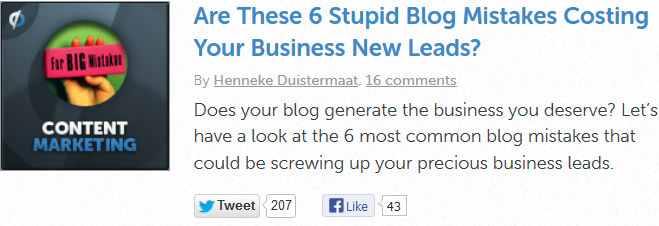Are you having difficulty getting your business’ blog off the ground? Do you write great content, and wonder why your readership is struggling?
Recent studies show that while 80% of people will read headline copy, only 20% will read the rest. This is the hidden importance of great titles, and why getting them right is so vital to a successful blog.
In this article I’ll break down 10 strategies for writing great blog headlines, giving you concrete examples from some of the most successful content marketers in the biz. I’ll also give you examples you can use for your business, no matter what that business is.
1. New! Never-before-seen Insights into [your Job]!
Cutting-edge information is one of the best ways to attract readership, especially in the ever-changing business of the internet. People are trying to find an edge, and offering it through new information is the most common way of attracting your reader.
Here’s a Real-life Example from Alex Sobal on SocialMediaToday’s Blog:
- New Phone App Makes Home Delivery a Breeze
- New Micro-Durable Fiber Changes Winter Jackets Forever
- New Technology Makes your Blue-Prints Obsolete
2. Exclusive Strategies from [a Sector Expert]
Behind-the-scenes reveals from experts are a great way to tempt readers. They function in the same way as new information does – offering that extra little bit of knowledge that (you say) could make all the difference.
Here’s a Real-life Example from Ritika Puri on Unbounce’s Blog:

How you can do it:
- 10 Tips for Keeping You Looking Young (from the Health Guru)
- How I Brought my Restaurant Through the First Year
- Staying Sane in your Cubicle (by a 25-year Middle-Manager)
3. 10 Things you Need to Know in Order to Succeed
Using phrases like ‘need to know,’ ‘must have’ or ‘make sure’ demands your reader pay attention, because they could be missing out on something amazing. Although they might not believe you, few will take the chance.
Here’s a Real-life Example from Jeff Bullas’ Blog:
- 10 Strategies for Surviving a Call Center
- The Retailers Guide you Need to Read
- 10 Examples of Failed Cafes (and How you can Avoid their Fate)
4. The Secret Trick to [Achieve a Goal]
Exclusive information is king. Whether it’s new, exclusive to you, or an insight you’ve just realized nobody else knows, blast it on your blog. Selling secrets is a blogger’s bread and butter.
Here’s a Real-life Example from Brandon Anderson on Social MediaToday’s Blog:
Hopefully by now it goes without saying that using numbers (not spelled out) increases engagement with your blog. It’s also worth remembering that placing numbers at the beginning of a title tests better than in the middle or end.
How you can do it:
- The 10 Secrets For Keeping a Non-Profit Afloat
- 15 Corporate Law Secrets you Weren’t Taught at School
- The Secret Behind Apple’s Success (and how you can do it too)
5. How [Your Field] is Like…
Ah the metaphor! These are perhaps my most favorite blog articles. I love finding out how an author is going to make social media strategy like Batman, or PR work like a seven-layer dip. Readers approach this title with incredulity, and loved being proven wrong.
Here’s a Real-life Example from Barry Ricks on SocialMediaToday’s Blog:
- How a Restaurant’s First Year is Like the NFL
- How my Internship with Google was Like a Vacation in Mexico
- How PR work is like Middle School
6. How I [Did Something Unbelievable]
Like superlatives (greatest, best, most incredible) including hard-to-believe statements like the above entice your reader, making them think there’s something they’ve missed like a third hand or 36-hour day.
Here’s a Real-life Example from Julia Campbell on JCSocialMarketing’s Blog:
Something to keep in mind : Out of 100 articles, the most common title words associated with the most viral posts were smart, surprising, science, history, hacks (hacking, hackers, etc), huge/ big and critical. Just letting you know.
How you can do it:
- How I Made my First Million from Investing in Light bulbs
- How Our Gym Revolutionized Cardio for Women
- How I Went Bankrupt and Brought it all Back
What else I like about all these posts:
They’re to the point, without shoving it in my face. Being specific ensures your Search Engine Optimization (SEO) as much as superlatives and questions do. Their titles tell me exactly what I’m going to get, while at the same time teasing me with what they’re offering.
7. Amazingly Awesome and Sexy things you Should Read About
I use Amazing and Awesome a lot, and so should you. Headlines aren’t just about gripping you’re reader’s attention. They’re also about getting them there in the first place. This is where SEO comes in. Do you really think it’s a coincidence that Apple’s 2009 keynote address included the word ‘great’ 54 times and ‘incredible’ 26 times?
Here’s a Real life Example from Lindsey Kirchoff on Unbounce’s Blog:

Strong words are also a great way to turn a boring-sounding article into something a bit more exciting, as Ms Kirchoff has done above. Take the superlatives out of the title and you get ‘3 Ways to Identify Your Fans and Collect Customer Testimonials’. Did that grip you?
How you can do it:
- 10 Amazing Strategies to Ensure your Pet Store Succeeds
- 5 Life-changing Choices to help you Run Without Pain
- How the (Incredible) Ultra-Comfort Mattress Saved my Marriage
8. Are you Making this Mistake that’s [Leading to a Bad Result]?
Similar to ‘you need to know this!’, this title elicits that faintest bit of fear from the reader. They can’t help but ask themselves, ‘Oh heavens!, am I?’ And are immediately engaged.
Here’s a Real-Life Example from Henneke Duistermaat on Unbounce’s Blog:

A recent study from the US National Library of Medicine (bear with me) found that “aversive events exert greater influence over behavior than equal-sized positive-reinforcement events.” In non-shrink speak, that means people are more interested in avoiding bad outcomes than they are in engaging in good ones. Keep that in mind when writing your titles.
How you can do it:
- Are you Making the 5 Mistakes that Cost your Business Sales?
- Have you Fallen into the Shoe Store Trap?
- Avoid Bankruptcy by Following these 5 Accountancy Rules-of-thumb
9. How do you do [Activity]?
This kind of headline is just a matter of cutting to the chase. Ask the question your readers are asking, and then answer it in body of the blog. Readers who are skimming for information, especially if they’re looking for the answer to the question you pose, will jump at this title.
Here’s a Real life Example from Alyssa Kritsch on HootSuite’s Blog:
DIY and ‘Beginner’s guide to’ titles actually test better than ‘How-to’ titles. Keep it in mind!
How you can do it:
- How do you Balance your Checkbook?
- How do you Ensure your Architect Knows what They’re Doing?
- What Kind of Website Works Best for Retailers?
10. 10 Ways to [Improve in your Role]
Everybody wants to be the best. A headline which offers them that is always going to grab attention. Similar to #8, this post tells you the outcome from reading the article. Whereas in #8 it was “not losing millions”, in this it’s “making you better”. Test both formats and see which works best for you.
Here’s a Real-life example from Stefanie Grieser on Unbounce’s Blog:

When in doubt, piggyback. As Ms Grieser has done above by making stats ‘Tweetable’, you can always use trending or popular search terms to ride their wave of success. How about ‘What Facebook and Twitter know about Analytics that you Don’t.’ Even if your blog has nothing to do with either social media platform, it definitely sounds better.
How you can do it:
- 10 Ways to Make You a Great CEO
- 50 Tips to Maximize your Marketing Ability
- 10 Rules-of-thumb to Make you an Accounting God
Creating the Curiosity Gap
Wondering why, exactly, these work so well?
The basis of the tease (which all of the above, basically, are) is in psychology. There are enough articles on Professor Lowenstein’s ‘The Information Gap Theory of Curiosity,’ out there, and if you’re really interested a simple Google search will throw them all your way. For those of us who ate lunch at our desks today however… I’ll give you a synopsis:
The preeminent Dr Lowenstein from Carnegie Mellon states that:
Curiosity comes when we feel a gap “between what we know and what we want to know”. This gap has emotional consequences: it feels like a mental itch, a mosquito bite on the brain. We seek out new knowledge because that’s how we scratch the itch.
Creating this gap in your title (between a lack of knowledge and a fulfilment of knowledge) is my favorite way to convert an internet pedestrian, strolling along window-shopping, to a guy in my store, trying on pants.
Conclusion
I’d like to say these 10 approaches encompass all the best blog titles out there. Of course they don’t. Blogging is, at its heart, a creative field. So get creative!
Hopefully, though, they’ve given you a great place to start and some strategies to keep in mind.
Try combining approaches:
- #4 and #6 into: The 10 Secrets I Learned while Writing a Blog a Day
- #1 and #3 into: 5 New Developments in Facebook that you Need to Know.
- #2 and #7 into: Top 15 Amazing Exclusives from the Mastermind behind 10 million Twitter Followers.
Or have you found that getting straight to the point is still the best option? Does it depend on your business? Start the discussion below.
Related Reading
- 24 Amazing Facebook Giveaway Examples
- Facebook Landing Pages: 38 Ideas, Tips and Examples
- 5 Facebook Landing Page Template Examples Critiqued
- The 2017 Guide to Instagram Contest Rules
- Social Media Marketing Plan: An 11-Step Template
- 10 Terrific Instagram Tools for Business
- 25 Awesome Ideas for Giveaways on Facebook
- 25 Sure-Fire Facebook Contest Ideas
- 30 Amazing Examples of Branded Facebook Contests Done Right


